|
Taking the LEED
Three of Washington's premier architects and developers sat down with WL at Sette Bello Restaurant to dish on LEED certification, environmentally conscious planning and the importance of green development.
WASHINGTON LIFE: How do you define green?
SASSAN GHARAI: What you are trying to do is significantly reduce or eliminate the negative impacts of the building process and buildings as they exist. You do that through site planning, the HVAC (heating, ventilating and air conditioning) systems you choose, the materials you use and the construction process. You can even do it by figuring out alternative transportation for people.
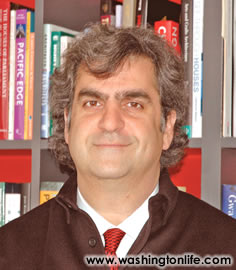 |
| Sassan Gharai founded SGA Architects in 1996. In 2006, its name changed to SGA Companies to reflect the variety of services being offered, which include design, development, land planning, space planning and construction. He is involved in designing and developing a wide array of building types throughout the United States. |
JIM ABDO: Site selection and access to public transportation are very important. There is a connectivity to smart growth and that is a critical component as we look at green buildings in and around urban centers. One of the things we are adamant about is trying to locate our projects close to, or with direct connectivity to public transportation. And you actually get LEED* points for that (see next page for explanation).
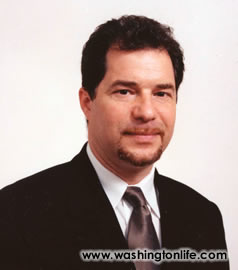 |
| Jim Abdo is the president and CEO of Abdo Development a real estate construction company that specializes in luxury, residential and retail properties. He sits on a number of boards, including the D.C. Preservation League, the D.C. Building Industry Association and Arena Stage. He is currently chairman of the Washington Convention Center Authority Board. |
YOLANDA COLE: The other thing different about designing a green building is the holistic approach.The hard thing for people to tease out is that the HVAC system you choose might affect ceiling depths or the lighting might affect the HVAC system. It is all interconnected, so it is hard for a developer who is new to this to know how much the LEED approach is going to cost. It is a more complicated process to do retroactively, so we try to encourage it from day one.
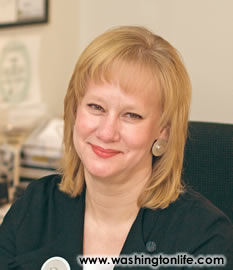 |
| Yolanda Cole, principal and owner of Hickok Cole Architects, has 25 years of experience in commercial office buildings, multi-family housing, mixed-use developments and corporate interior design. She is also co-chair of the Regional Development Task Force at the Greater Washington Board of Trade, which supports transit-oriented, smart growth development in the region. |
GHARAI: It works both ways. You can add LEED at the end because the thing about LEED is you only get positive points. But Yolanda is r ight, it is much easier to incorporate from the beginning.
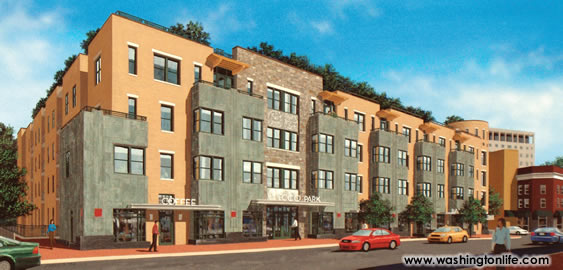 |
| SGA Companies Ecco Park, which utilizes green materials and is located next to the Takoma metro station |
WL: What materials are you using in your projects that help green development?
COLE: The product world is catching up quickly, so the things that we choose are not all that special anymore. They are becoming more ordinary - such as low VOC (volatile organic compound) paints and carpets that are made of recycled content. Bamboo flooring has been around for quite some time and you can use fly-ash concrete. All that stuff is now becoming available.
GHARAI: My favorite material right now is a sustainable, durable surface material called Ice Stone, made out of recycled glass and glue and stone dust.
ABDO: Green roofs and filtration systems. We are lining a site with a really cool system called a Filtera Stormwater Bio-retention system that is actually quite beautiful. It captures water and runoff but instead of it being in a traditional sewer head, you have green plants and trees that grow out of this system that the water flows through.
WL: Let's talk about green roofs.
GHARAI: There are really three types of green roofs: one with sedum which is about one and a half to three inches thick that you can root certain types of plants in; another is about six to eight inches thick on which you can plant grass; and a third that is 12 inches and above which uses regular soil and is much heavier that you can actually walk on.
WL: What are the costs compared to traditional roofs?
ABDO: A lot of developers will push back because they are thinking, "Oh my gosh, the expense." But if you look at the payback and the life expectancy of a green roof, it is off the charts - you can get a green roof that will last 100 years. And when you add in the aesthetic advantages, it is a no-brainer.
GHARAI: One of the most amazing things about the modern city is its lack of trees and vegetation. Cities could be cooler. What happens is all that concrete and tarmac and asphalt captures heat. One of the great things the green roof does is counter this effect. So, I think as green roofs proliferate throughout the city, the legendary Washington summer should become a little more bearable.
WL: What are some green measures that are easy to achieve?
COLE: If you are located near transportation, you've got the LEED point without even thinking about it.
ABDO: Is there low-hanging fruit that developers can go for? Absolutely. Look at the Wooster and Mercer Lofts we are developing. They include all of the Energystar appliances, the high energy-efficient heating and cooling system, high energyefficient window ratings and things of that nature.
COLE: If you are building and designing high quality buildings, you are already going to have a lot of points through the LEED system because you are doing things that make sense for anyone who is going to hold a property for any period of time.
GHARAI: One of my favorites is using indigenous plants. The most bang for the buck is heavying up insulation in the walls so that your building becomes more energy efficient. One of the easiest things is putting in a space for bicycles and a changing room for bicyclists.
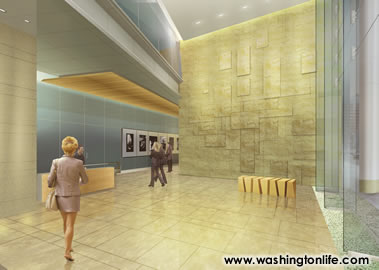 |
| A rendering of the lobby of Hickok Cole Architects' 1050 K, which is going after Gold LEED certification |
*LEED certifi cation is the recognized standard for measuring building sustainability. It was developed by the U.S. Green Building Council, a D.C. nonprofi t coalition of building industry leaders. The rating system offers four certifi cation levels: Certifi ed, Silver, Gold and Platinum, which correspond to the number of credits accrued in fi ve green design categories: sustainable sites, water effi ciency, energy and atmosphere, materials and resources and indoor environmental quality.
WL: What is the biggest incentive for you to develop green buildings or create green designs besides a moral obligation?
GHARAI: I think it has to do with people and their living environments. Living green means that you don't get stuck in traffic for two hours every day; that you don't get sick from the building you live in; you don't get headaches; you are not constantly disturbed by the sound of HVAC clicking on and off ...
ABDO: There is a moral obligation - a level of social responsibility that all of us should have. If you are in the development and design world, at the end of the day, you are making changes to the overall environment with our projects. And you should do that in a sensitive way. So I think that anyone committed to LEEDcertification and green buildings looks at that moral obligation very seriously.
COLE: When I am giving a presentation to developers, I'll put the argument in reverse order. I tell them that it saves money and creates higher asset value in the long run. That is what a developer wants to know - if they are going to put more money into it, is it going to pay back - and when? And afterwards, because it is a smart and responsible thing to do. If you say to people, "Well, we should all be good environmental stewards," you are not necessarily going to get to the point. You have to hit them where the bottom line is.
WL: Last year the D.C. City Council passed the Green Building Act requiring the mayor to submit a comprehensive set of green building standards by January 1st, 2008. These are expected to include the 2006 International Energy Conservation Codes, and starting in 2012 may require all commercial development of 50,000 square feet or greater to qualify for LEED certification. What else do you expect from Mayor Fenty when he submits his plan?
GHARAI: That is a great start but I don't think there is much more he can do. The only organization out there is the U.S. Green Building Council and LEED certification is the only way of quantifying whether a building is green or not.
COLE: One of the other things I have heard is that D.C is going to provide an incentive for private developers to do LEED-certified buildings by providing expedited permitting in 30 days.
ABDO: That's cer tainly an enticement. I agree that the U.S. GBC, overseeing LEED certification, is all that's out there. It's sort of like the Good Housekeeping Seal of Approval. You are either LEED certified or you are not. And there is really no one else that can take you through that process.
WL: D.C. provides rebates to citizens who install Energystar appliances. When you work on projects, do you consider using Energystar appliances?
ABDO: I asked the folks around the office about this because I'm not into that level of detail. And the answer was it is hard to find appliances that aren't Energystar. All of ours are.
COLE: Yes, everything is.
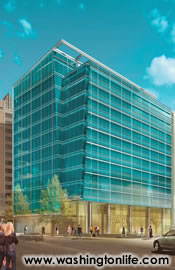 |
| The exterior of 1050 K, a 140,000 square foot office building designed by Hickok Cole Architects. It features a green roof and bio rentention system that collects water and feeds the landscaping |
WL: How important is urban infill to green development?
ABDO: It is everything that my whole company is built on. We've never turned green space and wetlands into subdivisions. We need to start thinking inward when we think about housing - it is a very simple formula. Bring people closer to where they work. The ripple effect and benefits are exponential. I mean you are talking about cleaner air, more preserved green space, preserved wetlands, less congestion on your roads ...
GHARAI: Something that is really interesting is the shift in the culture of American cities. People are moving back to the cities. And you can see it, especially in D.C., with new theaters, new restaurants, and even some grocery stores. The city is in a period of transition and green architecture will be an integral part of it
COLE: The majority of our work at Hickok Cole is urban. It is easy to build a building on a nice green flat site. But there is something more challenging, fun, interesting and puzzle-like that goes along with infill projects.
WL: What projects are you working on that are particularly green?
GHARAI: We have Ecco Park in D.C., right next to the Takoma metro station, which is done really well. I was in the sales center and was encouraged by how much people really cared about the ecofriendly materials.
COLE: We are designing a 140,000 square-foot office building - 1050 K Street, N.W., -that is going after Gold LEED certification. During the design process, the client really wanted to do something cool, exciting and cutting edge, like a double skin or using photovoltaics or some other kind of eye-catcher. So, we went through the process of looking at a double skin and did all the energy modeling. We looked at photovoltaics. None of this paid off. What happens is that you end up doing a lot of the things that just make sense. We have a big, beautiful green roof. We have a glass curtainwall with sunshades on the western façade. We have a bio-retention system that collects water and then feeds the landscaping. But all of this stuff is fairly ordinary now - and that's a good thing. It's a beautifully designed, efficient building that uses straightforward systems and is also kind to the environment.
ABDO: We're working on Arbor Place at the eastern gateway of the city at our New York Avenue/ Bladensberg Road site, which is 16 acres of land that currently has junkyards, a strip club, gas stations and chop shops. We are turning it into an urban village that will have its own private three-acre central park right in the center. While we are putting three and a half million square feet of density there, if you look at our overall site plan, five and a half acres of the 16 is all green space and 65 percent of all the roofs are green. We didn't have to do that, but we did voluntarily because we wanted to create a very livable community.
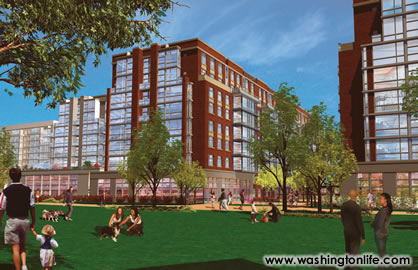 |
| A rendering of the three-acre park that will be the central feature of Abdo Development's Arbor Place community at the eastern gateway of Washington, D.C. |
|







